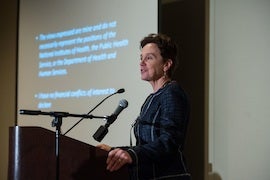Renowned Nurse Bioethicist Delivers NHS Values Based Lecture

Posted in GUMC Stories
 A member of President Obama’s Presidential Commission for the Study of Bioethical Issues said at Georgetown Thursday night that she first became fascinated with the concept of the common good while caring for bone marrow transplantation patients early in her nursing career.
A member of President Obama’s Presidential Commission for the Study of Bioethical Issues said at Georgetown Thursday night that she first became fascinated with the concept of the common good while caring for bone marrow transplantation patients early in her nursing career.
“Bone marrow transplantation was a very new phenomenon,” said Christine Grady (NHS’74, G’93), PhD, RN, FAAN, now the chief of the National Institutes of Health’s Clinical Center’s bioethics department. “It was an experimental phenomenon. …We got very attached, as you might imagine, to the patients that we worked so intensely with. It raised so many questions in my mind.”
One of them, she said, was how could the institution she worked for continue to expend so many resources – a two-to-one nurse/patient ratio for each shift – for these patients when there were women in the community who were not receiving prenatal care.
‘The Right Way’
“It used to bother me when I thought about those things,” she said. “What’s the right way to expend resources – both mine and the resources of money and other people’s energy?”
Grady shared a number of personal stories during a keynote address March 21 for the School of Nursing & Health Studies’ annual Values Based Lecture, sponsored by the school’s Committee on Mission and Values and the Minority Health Initiative Council.
The renowned nurse bioethicist specifically addressed “value of the common good,” one of the school’s core values.
Different Understandings
While most people support the common good in society, they might disagree with how that is defined, said Grady, who earned her bachelor’s degree in nursing and doctorate in philosophy at Georgetown.
“One of the things that I read in preparation for this [lecture] said, ‘valuing the common good is sort of like mom and apple pie,’” she noted. “Who would ever say they’re against the common good? Nobody. But if you ask them what do they mean by it, they probably have very different understandings of what that exactly means – not only in the abstract, but in terms of how they live their life or how they practice their profession.”
Good of Society
In the health fields, “most people have some kind of notion like this when they say the value of the common good,” Grady said. “It’s somehow focused on the whole – on the good of society, on the good of populations.”
But a conflict emerges, she said, when choices need to be made in resource allocation among differing social goals, such as investments in health care or education, primary care or specialty care, prevention or treatment, research or clinical care.
An added tension arises when considering the interplay between individual rights and the common good, including patient confidentiality and protection of research subjects, she explained.
Communal Interest
“As a health care provider and as a bioethicist, I think we are … committed to both the interests and goods of the individuals that we connect with in our professional life,” she said. “That’s a lot of what we’re committed to as nurses is taking care of patients that are assigned to us, whether they are individuals or communities.”
A balance must be struck with communal interest as well, Grady said.
“At the same time, in so many ways as health care providers, as researchers, as bioethicists, as administrators, as policymakers,” she explained, “we have a responsibility for thinking about the common good and for valuing the common good and for making the tough choices that we sometimes have to make to get the right balance between those two.”
Important Balance
Laura Anderko, PhD, RN, the Robert and Kathleen Scanlon Chair in Values Based Health Care and Committee on Mission and Values co-chair, welcomed the audience and Juan Dent (NHS’14), an international health major and co-chair of the Minority Health Initiative Council, introduced the speaker.
“I loved it,” Dent said after the lecture. “I really liked her approach, especially the balance between the common good and individual rights.”
Click here to watch the event video.
By Bill Cessato, NHS Communications
